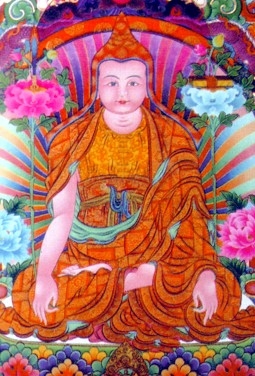Nyingtik Yabshi
Nyingtik Yabshyi (Tib. སྙིང་ཐིག་ཡ་བཞི, Wyl. snying thig ya bzhi) literally means the 'Four Parts of the Nyingtik'.
Nyingthig Yabshi (snying thig ya bzhi) (སྙིང་ཐིག་ཡ་བཞི) - the Four-fold Heart Essence
The Nyingthig Yabshi, one of the most famous set of Dzogchen scriptures, was compiled by Longchenpa to condense the two primary lineages of Dzogchen practice in Tibet, those of Padmasambhava and Vimalamitra. Together, this collection of texts is considered the core teaching on the practice of Dzogchen, and in particular the Heart Essence teachings of the Instruction Class.
The teachings of Padmasambhava on the Innermost Unexcelled Cycle are contained in two volumes and are referred to as the Khandro Nyingthig (mkha' 'gro snying thig. Longchenpa's commentaries on this cycle of teachings comprise three further volumes, which are known as the Khandro Yangthig (mkha' 'gro yang thig).
The teachings of the Vimalamitra's lineage, which unite the two aspects of Innermost Unexcelled Cycle — the explanatory lineage with scriptures and the hearing lineage without scriptures, are contained in four volumes, known as the Vima Nyingthig (bi ma snying thig. Longchenpa's 51 commentaries on this cycle of teachings comprise two volumes, which are referred to as the Lama Yangthig (bla ma yang thig).
Longchenpa also wrote two volumes of commentary that relate to both lineages, entitled Zabmo Yangthig (zab mo yang thig).
Explaining the content of this collection of teachings, the 3rd Dzogchen Rinpoche writes:
"The import of the three classes, the nine-fold expanse, and all the other key instructions of the Great Perfection were condensed by the Kashmiri scholar Vimalamitra and codified in the Secret Heart Essence, the Sangwa Nyingtik. These teachings came to be known as The Vast Heart Essence of Vimalamitra, or Vima Nyingtik. The Heart Essence of the Ḍākinīs, or Khandro Nyingtik, was codified by Padmakara, the master from Oḍḍiyāṇa. His teachings came to be known as The Profound Heart Essence of Padma, or Pema Nyingtik. The omniscient Longchenpa then wrote short commentaries on the first of these and more extensive commentaries on the second. The former is referred to as The Quintessential Wish-fulfilling Jewel, which is also known as The Guru’s Quintessence, or Lama Yangtik, and the latter as The Ḍākinī’s Quintessence, or Khandro Yangtik. All of these teachings were then gathered into one compilation, thus condensing both the transmitted teachings and treasures. This collection is referred to as the Four-fold Heart Essence, the Nyingtik Yabshi." (from shing rta bzang po, p. 257) CJD
It consists of the
The Vima Nyingtik and Khandro Nyingtik are known as the 'mother Nyingtik texts and the Lama Yangtik and Khandro Yangtik are known as 'child texts, hence another common name for the collection which is the Four Mother and Child Sections of Nyingtik (Tib. སྙིང་ཐིག་མ་བུ་བཞི་, nyingtik ma bu shyi).
Longchen Rabjam also composed the Zabmo Yangtik, which condenses the important pith instructions of both Vima Nyingtik and Khandro Nyingtik.
As Nyoshul Khen Rinpoche explains: “For the purpose of the actual practice of Dzogchen according to the seventeen main tantras of Dzogpachenpo,
Longchenpa gathered his own termas as well as those of Chetsün Senge Wangchuk (who was later reborn as Jamyang Khyentse Wangpo), and Pema Ledreltsal (Longchenpa’s previous incarnation) in the form of the thirteen volume collection known as the Nyingtik Yabshyi.
This is the practice aspect of Longchenpa’s writings and the basis of the Old Nyingtik.
In it he synthesized the Vima Nyingtik of Vimalamitra and the Khandro Nyingtik of Guru Rinpoche and explained all the practical details in the light of his own realization.”[1]
Contents
Alternative Classifications
There are two alternative traditions of classifying the Four Parts of the Nyingtik, mentioned in the Immaculate Oral Instructions, the Nyingtik teachings of Jamgön Kongtrul:
A second classification includes:
- Vima Nyingtik
- Lama Yangtik
- Khandro Nyingtik and Khandro Yangtik, counted as one; and
- Karma Nyingtik, which comes from the Third Karmapa, Rangjung Dorje.
A third way of classifying the four, according to the Dzogchen masters Kongpo Dzogchenpa and Katok Rigdzin Tsewang Norbu, is as follows:
- Vima Nyingtik;
- Lama Yangtik;
- Khandro Nyingtik and Khandro Yangtik, counted as one; and
- Dorsem Nyingtik of Kunkyong Lingpa.[2]
Alternative Translations
- The Fourfold Heart Essence (Cortland Dahl)
- The Four Higher Collections of the Heart Drop (Lama Chökyi Nyima)
The Empowerments of Nyingtik Yabshyi
The empowerments have been given many times to the Rigpa sangha, including:
- Kyabjé Dilgo Khyentse Rinpoche, London, 1st July 1987 (Lama Yangtik and Khandro Nyingtik only)
- Kyabjé Penor Rinpoche, London, 11th - 15th November 1988 (all empowerments including Zabmo Yangtik)
- Kyabjé Dilgo Khyentse Rinpoche, Prapoutel, 20th and 21st August 1990 (Khandro Nyingtik only)
- Kyabjé Penor Rinpoche, Lerab Ling, 18th - 21st July 1995 (not including Zabmo Yangtik)
- Kyabjé Trulshik Rinpoche, Lerab Ling, 1st July 2003 (Lama Yangtik only)
- Kyabjé Trulshik Rinpoche, Lerab Ling, 1st - 3rd December 2005 (Lama Yangtik and Khandro Yangtik only)
- Kyabjé Yangthang Rinpoche, Lerab Ling, 7-11 August 2013 (all empowerments including Zabmo Yangtik)
Tibetan Texts
 སྙིང་ཐིག་ཡ་བཞི།, Adzom Drukpa edition
སྙིང་ཐིག་ཡ་བཞི།, Adzom Drukpa edition སྙིང་ཐིག་ཡ་བཞི།, Tarthang Tulku edition (Yeshe De).
སྙིང་ཐིག་ཡ་བཞི།, Tarthang Tulku edition (Yeshe De).
Notes
- ↑ As quoted in Dzogchen & Padmasambhava, Rigpa Publications, page 85.
- ↑ See the foreword to Great Perfection: Outer and Inner Preliminaries, by the Third Dzogchen Rinpoche, translated by Cortland Dahl (Ithaca: Snow Lion, 2008), page xi and Dezhung Rinpoche (2005) p. 171
Teachings Given to the Rigpa Sangha
- Orgyen Tobgyal Rinpoche, Lerab Ling, 3 August 2013
Further Reading
- Cortland Dahl, in Entrance to the Great Perfection, A Guide to the Dzogchen Preliminary Practices (Snow Lion Publications), Appendix III, 'The Fourfold Heart Essence'.
- Dezhung Rinpoche, snying thig ya bzhi'i rnam bshad in kun dga' bstan pa'i nyi ma, gsung 'bum, Dharamsala, 2005, pp.169-179
- Dzogchen Ponlop Rinpoche, in Great Perfection – Outer & Inner Preliminaries', translated by Cortland Dahl (Snow Lion Publications), Foreword pp.x-xi.
- Khenchen Namdrol Rinpoche, Nyingtik Yabshyi, Its Origins and Transmission
Internal Links
see also: Nyingthig Yabzhi
